by Babak Taghvaee
Designed and built to be the Soviet Union's main aerial firefighter aircraft, now over 30 years after its collapse, Antonov An-32P Fire-Killer is Ukraine's key firefighter aircraft.
The State Emergency Service (DSNS) of Ukraine and Xena Airline, a Ukrainian company based in Zaporizhzhia, are currently the key operators of An-32Ps in Europe using them not just for firefighting operations inside Ukraine but also in other countries. Capable of airdropping eight tonnes of water in two passes, An-32P Fire-Killer is a unique firefighter aircraft capable of carrying a considerable number of firefighters and their equipment. In this article, we review the history and current fate of the Ukrainian An-32Ps.
Antonov An-26P, the father of An-32P4
What gave birth to Antonov An-32P during the existence of Soviet Union (USSR), was Antonov An-26P, a light transport aircraft equipped with external water tanks which were used together with Ilyushin Il-76MDP heavy fire-fighter aircraft for aerial firefighting during the final years of the USSR’s existence. History of An-26P itself dates back to the early 1980's when the increase in rate of wildfires across the Soviet Union during the fire-season showed lack of adequate means of aerial firefighting equipment in the country. In those years, just a small number of helicopters and aircraft were equipped with special equipment for aerial firefighting. They were less than ten Mi-8TL, Ka-26 and Ka-32T helicopters as well as three Antonov An-24LP twin-engined light transport aircraft and one An-2L and nine An-2LP piston-engined bi-planes
For almost 16 years, An-24LPs were the largest and fastest aerial firefighting assets of the country. They were in fact three An-24RV transport/passenger aircraft that had been converted to firefighter aircraft in 1971 by the Antonov Design Bureau and its factory in Kyiv to be used as a replacement for the sole Mi-6PZ firefighting helicopter of the country that was in use since 1967. Compared to Mi-6PZh, An-24LP was faster and also had lower operational costs. In the same year that An-24LP was born, the State Scientific-Testing Research Institute of the Soviet Union Air Forces (NII VVS) also developed a new heavy firefighting helicopter, Mi-6PZh2 which was equipped with steerable water cannon and was operated for firefighting missions in large cities such as Moscow by the military unit 03602 of the Soviet Army Aviation Forces at Uprun until November 5, 1991.
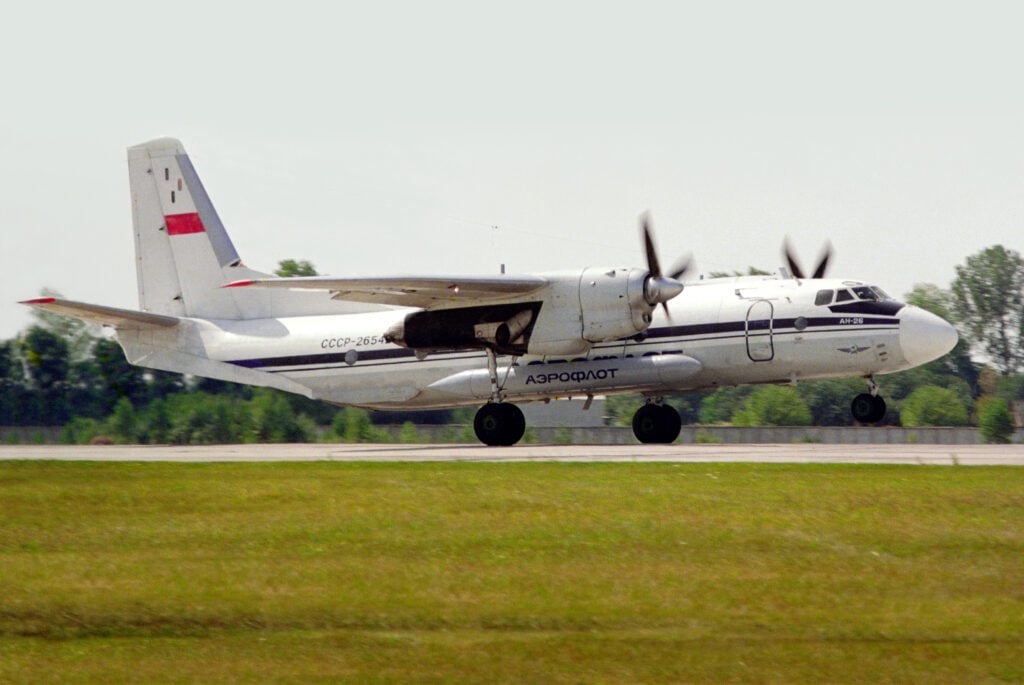
The three An-24LPs, 'CCCP-47818', 'CCCP-47819' and 'CCCP-47820' were flown by Aeroflot and were based in three locations in the USSR. They were equipped with two DB3-34 bomb racks (under the portside and starboard side of the fuselage) each capable of carrying 500kg of silver iodide pyrotechnic cartridges for cloud seeding PV-26. They also had a water tank at the bottom of their cabin, capable of holding four tonnes of water. Special hatches were installed under the fuselage allowing drop of the water in eight seconds.
In 1987, the three An-24LPs were determined to be incapable of meeting the needs of the USSR to be a lightweight transport aircraft capable of performing aerial firefighting missions. An-26B light transport aircraft which was a more powerful and modern variant of An-24RV was selected as the platform of the new firefighting aircraft. The Antonov Aircraft Design Bureau and GosNII GA (State Research Institute of Civil Aviation) were tasked to develop the An-24LP’s replacement. Named An-26P, it was equipped with two external fuselage water tanks each capable of holding two tons of water or fire-retardant.
The An-26P could also carry up-to 30 firefighter paratroopers and 100kg of their equipment who could jump out of its ramp door after one or several drops of water over the target area. In addition to that, the aircraft had two hardpoints under the starboard and port sides of its fuselage to carry two DB3-35 bomb racks. By means of them, each bomb rack could hold an ASO-2I cartridge dispenser capable of holding and dispensing a total of 192 PV-26 cartridges each for cloud seeding operations and the use of rainwater to extinguish wildfires.
The operational radius of the An-26P with full water tanks was 430 km. In one operational flight, this aircraft was able to sprinkle an area of three hectares. Given that forest fires usually could affect larger areas, the aircraft was unable to effectively extinguish fire in just one sortie.
The first An-26P prototype, 'CCCP-26661' flew for the first time in 1987. After completion of its state tests in around one year, serial conversion of four more An-26s took place. Painted in Aeroflot colors and flown by air and ground crew of the state airline, the aircraft were operated for Aerial Forest Protection Service of the USSR to use for firefighting operations together with their larger brothers, Il-76MDPs. For the first time in 1991, the An-26Ps were deployed from Arkhangelsk to the Lensk area to fight a wildfire there. Shortly after that, they were grounded due to lack of funds as a result of the economic crisis during the collapse of the Soviet Union.
During the mid-1990s, all five aircraft including CCCP-26542, CCCP-26551 and CCCP-26556, three of the four serial produced An-26Ps were de-converted back to An-26B cargo aircraft. Two of them 'RA-26542' (formerly CCCP-26542) and 'RA-26551' (formerly CCCP-26551) was withdrawn from use in late 1990's; one was converted into An-26-100 passenger aircraft and was sold to Valan ICC company that operated it from 2005 until 2017 when it crashed; and two others including RA-26661 (formerly CCCP-26661) were sold to Sudanese Air Force.
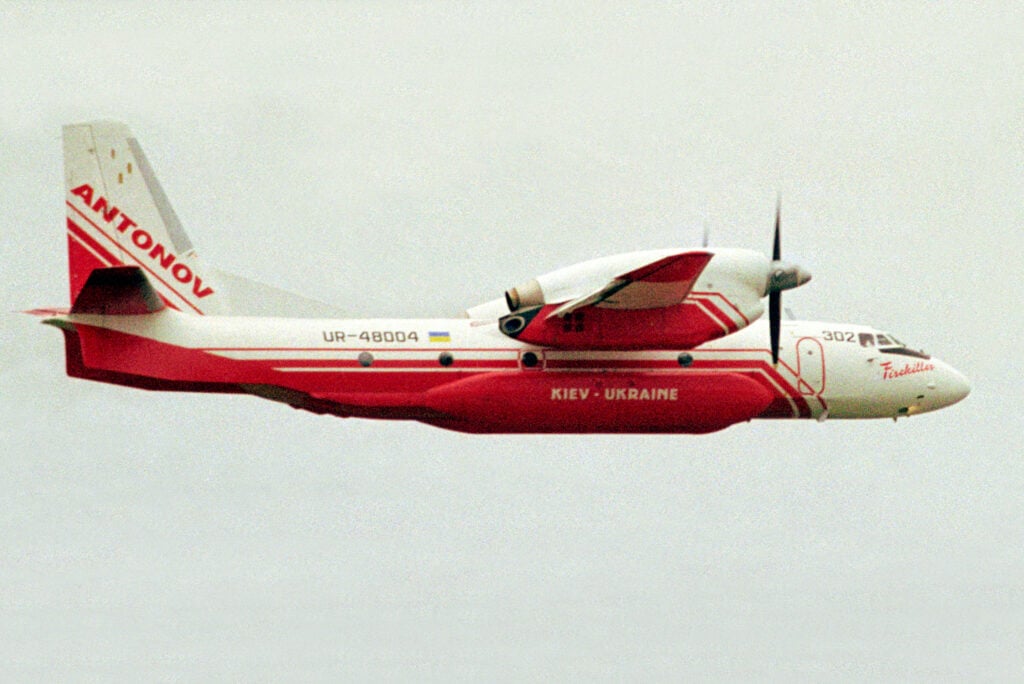
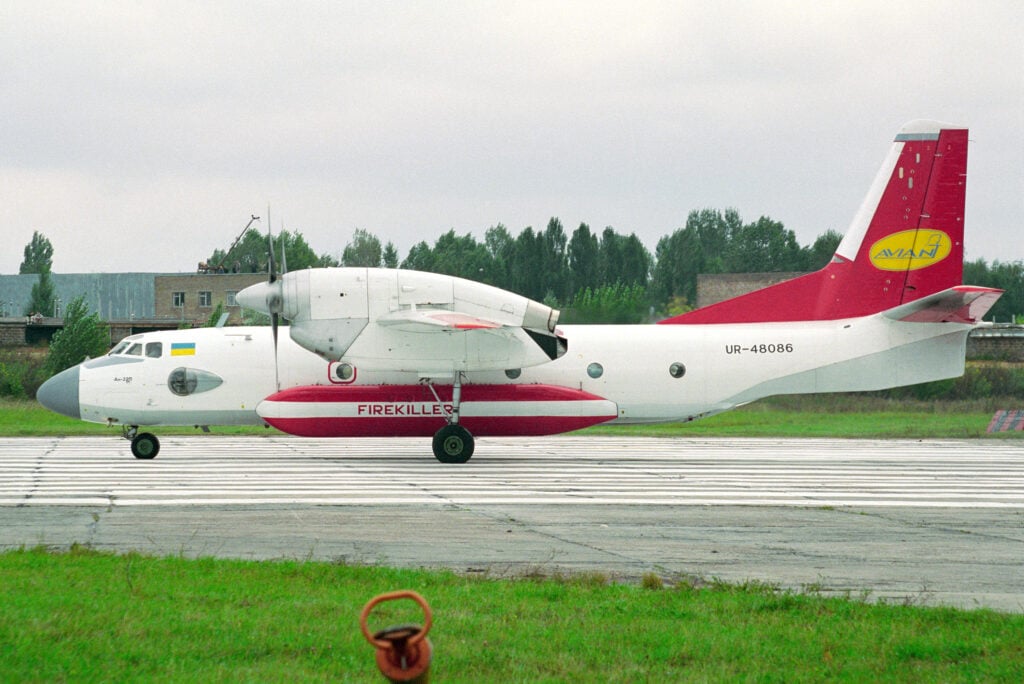
Birth of An-32P Fire-Killer
Started in 1987, the Aerial Forest Protection Service of the USSR used three An-26Ps for firefighting operations across the Soviet Union. The pair of Ivchenko Al-24VT turboprop engines of An-26P each had 2,820hp maximum power output which was insufficient to make the aircraft manoeuvrable enough to carry-out its operations in mountainous regions accurately and safely. Its pilots were mostly unable to drop water exactly on target. The underpowered engines could not allow pilots to descend and climb rapidly and safely with a maximum payload of 5,600kg including 4,000 litre of water as well as 30 firefighters and their equipment.
In 1990, An-32, a more powerful derivative of An-26, designed and built for the Indian Air Force for use in hot and high areas, was subsequently selected as the platform for development of a future replacement of An-26Ps. The Antonov Aircraft Design Bureau began design of the new aircraft named An-32P under supervision of Aerial Forest Protection Service of the USSR in 1990 which had planned to order 80 of them in 1993.
Each one of two Ivchenko Al-20D-2M turboprop engines of the An-32P had a maximum power output of 5,180hp enabling the aircraft to carry twice more water or fire retardant compared to An-26P. The aircraft had two tanks each with a total volume of 4,000 litres. The range of this machine with full external water tanks is 300 km.
Each one of the two tanks of the aircraft was divided in two sections allowing pilots to airdrop water in two passes each one equivalent to 4,000 litres. By dropping a total of 8,000 liters of water from an altitude of 40 to 50m at a speed of 240 to 260 km/h, the An-32P special vehicle sprinkles a strip of the earth's surface 120 to 160 m long and 10 to 35 m wide. The amount of water airdropped by the aircraft at each square metre exceeds a Litre.
Despite the collapse of the Soviet Union, the Antonov Design Bureau and the Kyiv Aircraft Manufacturing Plant continued working on the An-32P design and development in the independent Ukraine with a hope for its future sale in the international market of firefighter aircraft. The first prototype of an An-32P, (UR-48004), was created in 1992. It was flown for the first time on February 13, 1993 and then dropped water for the first time on March 15 of the same year during its 20th flight.
In the summer of 1993, the flight tests of the prototype An-32P (UR-48004) was suspended so that this machine could be presented to the general public at the Paris Air Show and subsequently also at the Moscow Air Show or MAKS 93. Shortly thereafter, in the fall of 1993, the test program of the prototype was interrupted again, this time due to the deployment of this aircraft for participation in the firefighting operations in the Yalta region (in Crimea), where extensive forest fires broke out just then.
Since the prototype proved to be effective in Crimea, the president of Ukraine at that time, Leonid Kravchuk, requested conversion of a second An-32 into a firefighter aircraft by the Antonov company. The Kyiv Aircraft Manufacturing Plant which had already manufactured components such as water tanks for installation on An-32 quickly completed the second example, 'UR-48018', in 1994. The aircraft also was quickly deployed to Crimea and joined the first prototype. They together performed 100 sorties during aerial firefighting operations in the Peninsula and their involvement in such operations delayed completion of their state tests.
The Elbit Systems from Israel leased both of the aircraft and used them for aerial firefighting operation during large-scale forest fires of Portugal between June and September 1994. They logged a total of 545 sorties in Portugal during which the second prototype (UR-48018) crashed due to pilot error on July 6, 1994. The accident impacted the An-32P Fire-Killer program and severed the relationship of the Aviation scientific and technical complex of O.K. Antonov and Elbit Systems. Russia also lost interest in the program as the Beriev Be-200 amphibious firefighter aircraft was under design and development in the country. As a replacement for the lost An-32P, a third An-32A was converted to Fire-Killer in Kyiv immediately.
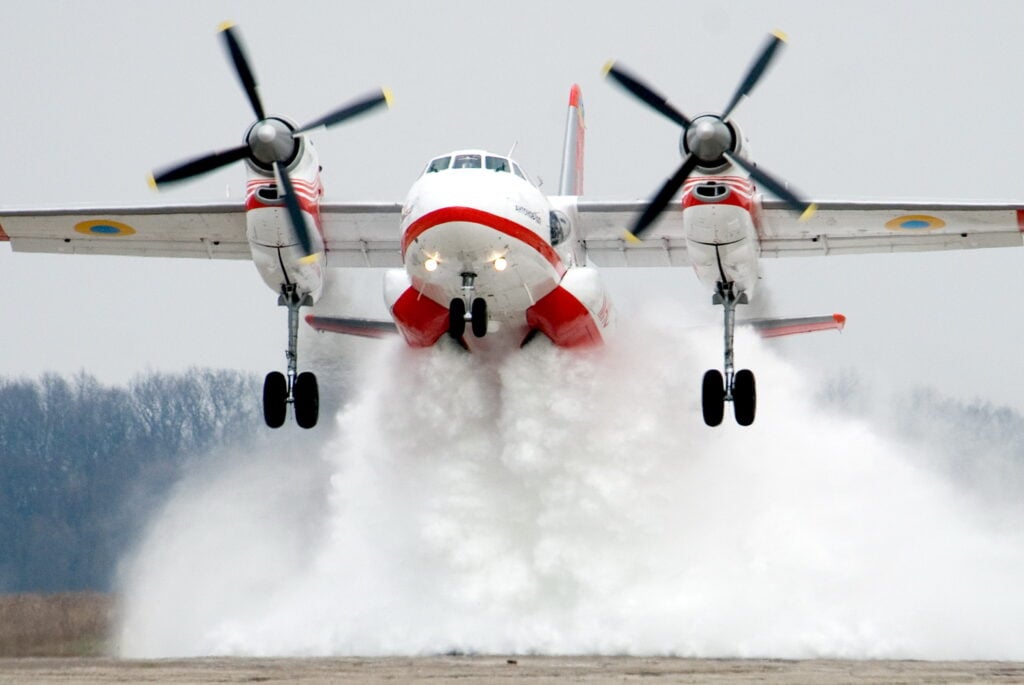
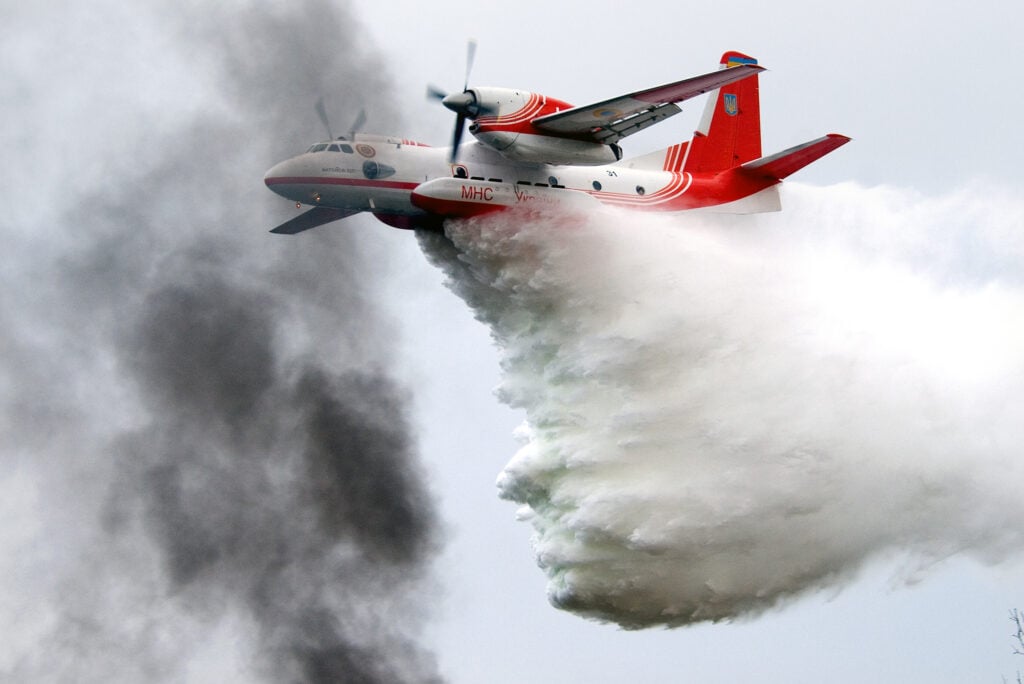
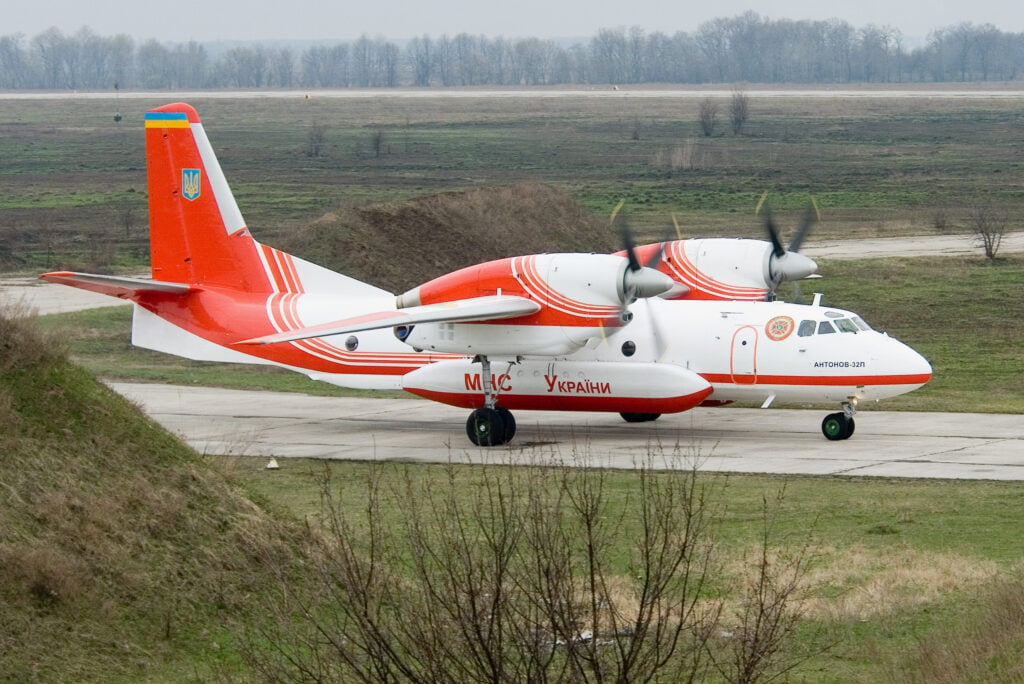
Libyan Air Force, the first customer of the Fire-Killer
Finally on March 10, 1995, the certificate of airworthiness of the An-32P prototype was issued by the Ukrainian Civil Aviation Authority following the completion of its state tests. The aircraft was subsequently presented to potential foreign customers in the Philippines, Malaysia, Australia and Thailand. After eight years of effort, finally the government of Libya became the first customer of the aircraft. A total of four of them were ordered for the Libyan Air Force with their production and delivery taking place in 2005 and 2006.
The Libyan An-32Ps with 0703, 1306, 3507 and 3602 construction numbers received civilian registration codes of 5A-DRC to 5A-DRF in Libya. 5A-DRC was a 1988 built An-32A that had been converted to An-32P in 1994; 5A-DRD was in fact UR-48004, the first prototype of An-32P; and 5A-DRE and 5A-DRF were two newly built aircraft that were manufactured between 2002 and 2004. After their deliveries, they remained in service until 2011 when the Government of Muammar Gaddafi fell. They were placed in storage in Mitiga Air Base, Tripoli. But six years later, two of them, ‘5A-DRE’ and ‘5A-DRF’ were restored to flying condition by Ukrainian contractors hired by the Qatari government in 2017.
They were flown from Mitiga to Misrata airport in 2018 and were operated by Libyan Dawn Air Force as transport aircraft for a couple of years until both became grounded due to lack of spare parts. One of them was damaged in an airstrike of an UAE Air Force at Misrata airport in 2019. A Blue Arrow 7 air-to-surface missile launched by a Wing Loong II armed drone struck a MiG-23MLD fighter jet parked next to the aircraft and caused its explosion. The missile’s shrapnel pierced the An-32’s fuselage and windows.
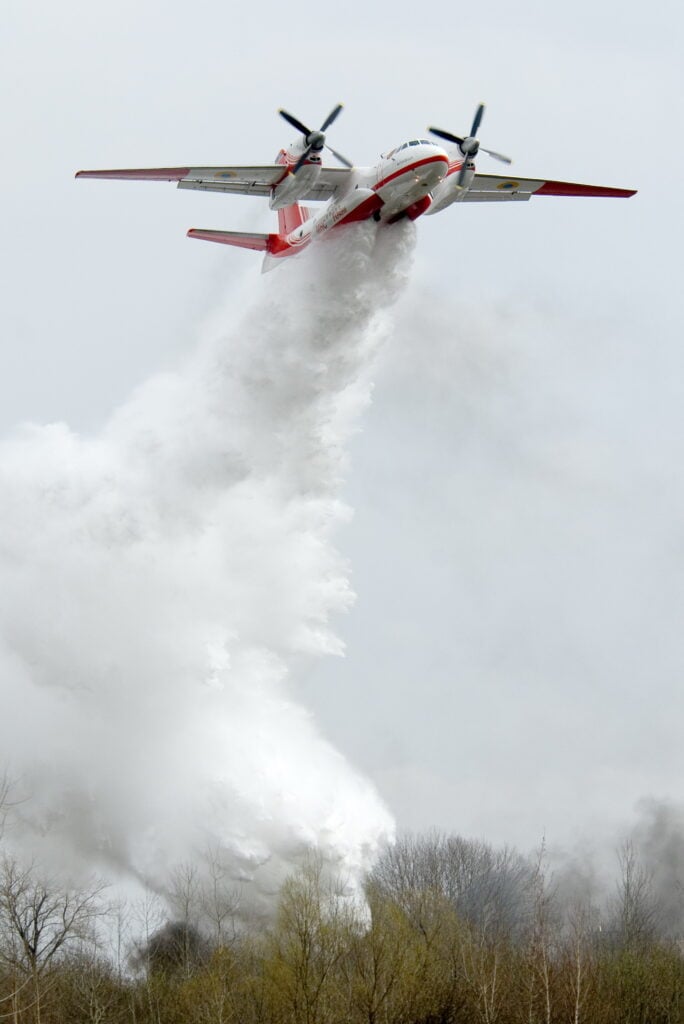
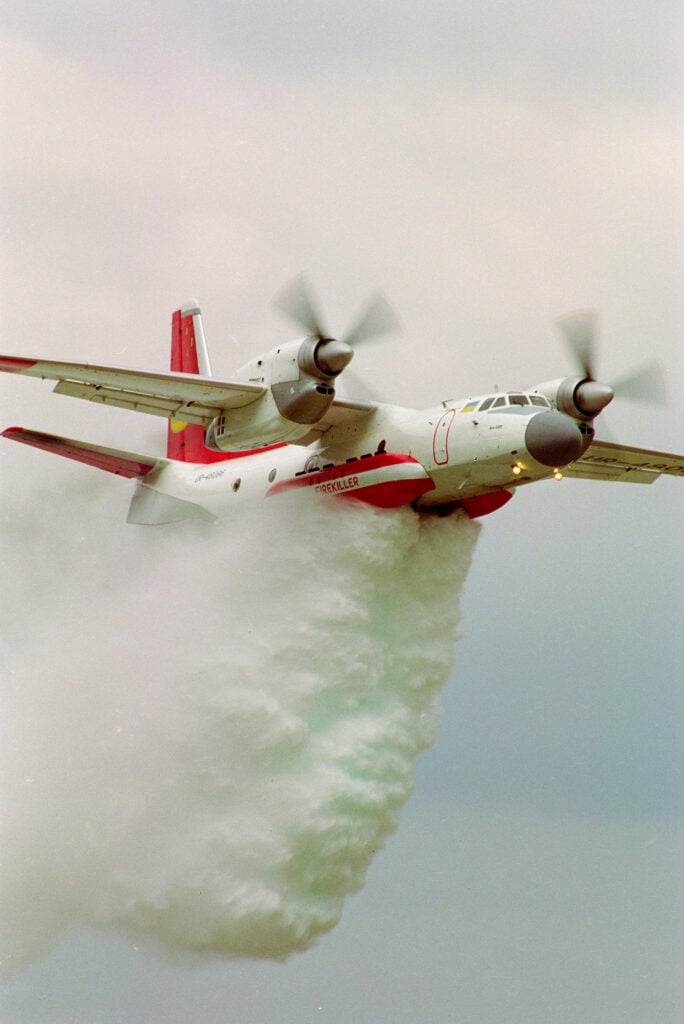
In service of the State Emergency Service (DSNS) of Ukraine
In 2007 and 2008, the Ukrainian Ministry for Emergency Situations (MNS) received four An-32Ps which received Black 31 to 34 tactical codes (also known as board numbers). The aircraft with 3608, 3609, 3610 and 3701 construction numbers were rolled-out of the factory on November 26, 2007, March 18, 2008, April 15, 2008 and July 2, 2008 respectively and were delivered a few months later and were based in Nizhyn airfield.
The flight unit of the Ukrainian Ministry of Emergency Situations already had two An-26 light transport aircraft and An-30B aerial photomapping aircraft when the An-32Ps arrived. The An-32Ps air and ground crew were mostly the former Ukrainian Air Force personnel who flew and maintained Tupolev Tu-22R strategic reconnaissance jets and Tu-22P heavy electronic warfare aircraft in service of the 199th independent Guards Brestskiy Long-Range Reconnaissance Aviation Regiment of the USSR Air Force (inherited by the Ukrainian Air Force in 1992).
Painted in white colors with red stripes, the aircraft had 'MNS Ukrayiny' markings written on their fuselage which was later changed to 'DSNS Ukrayiny' after the Ukrainian Ministry of Emergency Situations became the State Emergency Service of Ukraine on December 24, 2012. Missions of the DSNS were defined as civil defence, rescue, creating and managing the system of insurance fund documentation, utilization of radioactive wastes, protection of population and territory in emergency situations, emergency prevention and response, liquidation in the aftermath, and the Chernobyl catastrophe.
The first of four An-32Ps of the MNS were unveiled at the Kyiv Aircraft Manufacturing Plant, Aviant, in the presence of the Ukrainian Minister of Emergency Situations at that time, Nestor Shufrych. The first aircraft, ’31 Black’ (c/n 3608) valued 40 million UAH (Ukrainian Hryvnia) had its first acceptance flight performed at Svyatoshino airport on February 15, 2008. It was delivered to the Aviation Unit of MNS a few days later on February 19, 2008 when it was flown to its base Nizhyn. Deliveries of the remaining three, 32, 33 and 34 Black (c/n 3609, 3610 and 3701) took place on April 21, April 28, and July 17, 2008 respectively.
Just a few days after their deliveries, two of the An-32Ps (32 and 34 Black) together with two Mi-8Ts were sent to extinguish a mountain forest fire near the village of Semenivka, Izyum district, Kharkiv region on August 14, 2008. On August 16, they assisted in extinguishing forest fire in 900 hectares of land between the villages of Chervyn Shakhtar and Ivanivka of the Izyum. A day later on August 17, the aircraft were used to extinguish fire in 350 hectares of land near the village of Desna, Kozeletsky District.
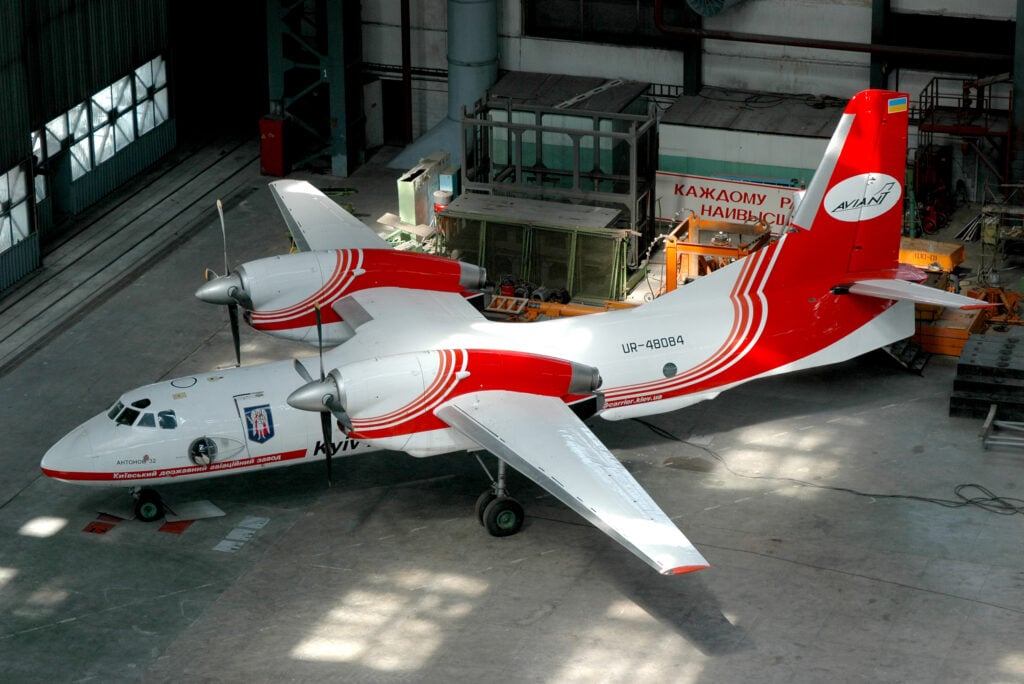
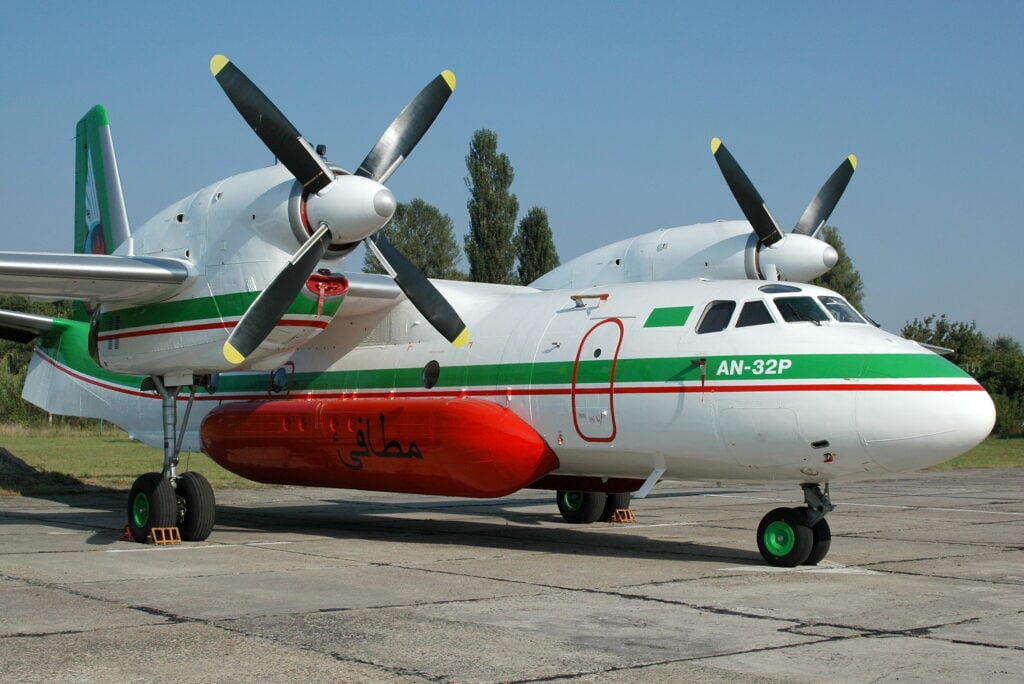
Some of the key firefighting operations of the DSNS that had these aircraft involved in Ukraine are the followings:
- On August 10, 2015, three An-32Ps and a Mi-8MT of the DSNS took part in firefighting operations to tackle a wild fire between the villages of Kovshylivka and Buda Varovychy.
- On August 18, 2017, a fire erupted in an industrial facility in the Shevchenkiv district of the city of Dnipro on Bohdan Khmelnytskyi Avenue. Due to its large scale, an An-32P was called by firefighters to airdrop eight tons of water over the burning site which was a factory. The water was dropped in two passes (four tons in each pass).
- On September 22, 2017, an An-32P became involved in a firefighting operation in the Krasnograd forest, the Kharkiv Oblast.
- On June 5, 2018, an An-32P and a Mi-8MT took part in a fire fighting operation in the forest near the Chernobyl nuclear facility. The aircraft logged seven sorties and dropped a total of 34 tons of water.
- Between October 10 and 16, 2018, two An-32Ps participated in firefighting operations in forests near the village of Druzhba. On the first two days, they airdropped 192 tons of water in 24 sorties. On the third day, October 12, they airdropped 112 tons of water in 14 airdrops.
- On September 12, 2019, two An-32Ps together with an EC-145 helicopter (used for reconnaissance) participated in firefighting operations for the elimination of a forest fire in a military training ground in Chirnihiv Oblast. They had six discharges of water for total amount of 48 tons.
- Between April 7 and 10, 2020, three An-32Ps got involved in firefighting operations in Kyiv and Zhytomyr Oblasts. Due to the significance of the fires, they had one H225LP and two Mi-8MT helicopters involved. The H225LP was used for reconnaissance while Mi-8MTs also airdropped water (120 tons) on April 8. On the same day, An-32Ps airdropped 168 tons of water.
- On April 9, 2020, two An-32Ps and a Mi-8MT of the DSNS fought wildfires in Kharkiv and Luhansk Oblasts of Ukraine; they dropped 192 and 104 tons of water respectively. More fires erupted in the Kyiv, Zhytomyr and Chernihiv regions the next day involving one more Mi-8, another An-32P and an H225LP of the DSNS involved.
In 2012, Antonov Company, formerly the Aeronautical Scientific-Technical Complex, offered DSNS a fifth An-32P. It was an An-32B manufactured by Antonov Serial Production Plant, formerly AVIANT between 2002 and 2010 and had been delivered to the Iraqi Air Force as a new aircraft in 2010 but was rejected and replaced by another aircraft in 2011. The An-32B with 3604 construction number was also rejected by the DSNS in 2012 and remained unsold in Svyatoshino for seven years until a second offer was given to the DSNS which once again rejected on October 16, 2019.
Two years later, DSNS decided to expand its fleet of An-32Ps as they also became heavily involved in international operations such as fire fighting missions in Turkey in August of that year. Subsequently, decisions were made to order conversion of the former Iraqi An-32B stored in Svyatoshino to a fifth An-32P for the aviation unit of the DSNS. On December 16, 2021, a contract for conversion of the aircraft was finalized between DSNS at Ukroboronprom company at the Antonov Serial Production Plant in Kyiv. Just a few months after that on February 24, 2022, Russia invaded Ukraine and interrupted conversion of the aircraft to an An-32P.
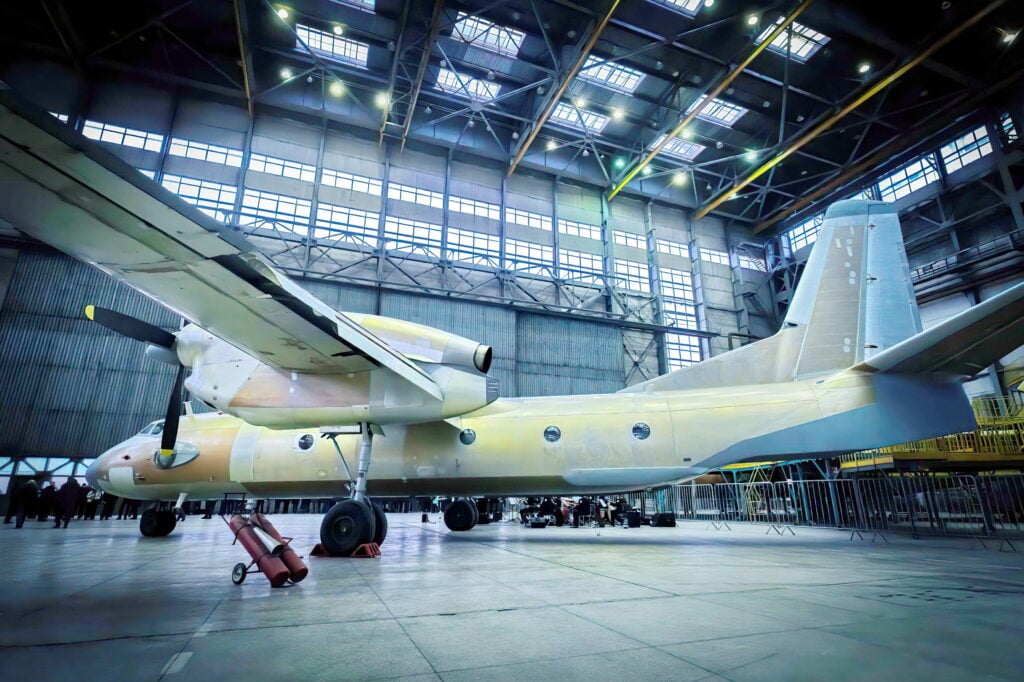
International Operations for the Ukrainian Fire-Killers
In addition to their participation in national firefighting operations, the Ukrainian Fire Killers of the MNS (later DSNS from 2012) participated in several international missions and operations starting with a deployment to Russia in 2010. Following an order issued by the President of Ukraine at that time, Viktor Yanukovych dated August 2, 2010 two An-32Ps were deployed to Voronezh Oblast (province) Russia to take part in firefighting operations from August 3 to August 17. They logged 144 hours of flight and dropped about 172 tons of water on the fires. 17 crew members of the aircraft were later awarded by the Russian Prime Minister Vladimir Putin and Minister of Emergency Situations, Sergey Shoigu.
An-32Ps of the Ukrainian MNS and later DSNS were not only used for firefighting operations. On October 26, 2011, one of them was flown to Erzurum airport in Turkey to provide humanitarian aid to Van province, where an earthquake occurred on October 23, which resulted in significant human casualties and infrastructure destruction. Another non-fire fighting operation of these Fire-Killers took place in 2012 when two of them were sent to Syria to ensure the return of Ukrainian citizens. On July 26, they took 62 people from Damascus. At 20:36 and 20:47 local time, they landed at Boryspil International Airport near Kyiv.
On November 25, 2016, in accordance with the Presidential Decree, two An-32Ps of the DSNS flew to the State of Israel to provide assistance in eliminating the fires raging there. The aircraft were 31 and 33 Black, carried out four water drops (a total of 32 tons) in mountainous areas near the city of Haifa. Aerial reconnaissance and patrolling of other territories was also carried out by them. In the next year, an An-32P, ’32 Black’ was deployed to Batumi to take part in a similar mission there on August 30 and 31, 2017.
On July 28, 2021, forest fires broke out near the city of Manavgat, Antalya province of Turkey, which is the territory of Osmaniye, Kayseri, Kocaeli, Adana, Mersin and Mugla provinces. They overwhelmed the aerial firefighting assets of the country in just two days resulting in a request for help from allies being issued by the Turkish government. Ukraine was one of the countries that answered the call. Between July 30 and August 30, 2021, two An-32Ps of the DSNS, ’32 Black’ and ’34 Black’, flown and operated by 14 personnel of the DSNS assisted Turkey in fighting wildfire across the country. During their presence in Turkey, they airdropped 992 tons of water in 124 sorties in Antalya and Isparta provinces of the country.
Fire-Killers at Ukraine War
During the first days of the Russian invasion, various air bases and airfields were targeted by the Russian Armed Forces using cruise and ballistic missiles. Subsequently, aircraft and helicopters of the Ukrainian Armed Forces as well as Aviation Unit of the DSNS were evacuated to the West of Ukraine as well as Poland. The DSNS flight unit had almost all of its aircraft and helicopters flown from Nyzhyn in Northeast of Kyiv to Bydoszcz airport in Poland on February 25, 2022.
During the war, Bydoszcz remained main base of the DSNS flight unit with two An-26s (01 and 04 Blue), two An32s (32 and 33 Black) and five H225LP helicopters but the An-26s and An-32Ps occasionally were deployed to Uzhgorod airport in western Ukraine just next to the border with Slovakia and Chernivtsi airport near Romania. During the first days of the war, these aircraft were used to fly to Germany and airlift fire fighting equipment donated by the German government to Uzhgorod and Lviv airports in the west of Ukraine.
Despite the war, the DSNS fleet of An-26 and An-32Ps remained heavily active conducting humanitarian aid missions in and outside Ukraine. Following the Earthquake of Turkey on February 6, 2023, one of the An-32Ps together with an An-26 of the DSNS with 77 rescuers onboard were sent to the country to provide assistance in humanitarian relief operations.
In 2023, the Ukrainian government reached an agreement with the Croatian government following mediation of the US Government for transferring the Soviet made equipment and weapons of the Croatian Armed Forces to their Ukrainian counterparts. As a part of the agreement two Mi-8T and 14 Mi-8MTV-1 multipurpose helicopters and two An-32B light transport aircraft of the Croatian Air Force were scheduled to be delivered to the Ukrainian Army Aviation Corps and DSNS respectively. While the helicopters were mostly delivered in 2023, deliveries of the An-32Bs took place in 2024.
The two An-32Bs, '707' (c/n 3310) and '727' (2810) were built in 1991 and 1992 and had been procured by the Croatian Government in 1996. They were operated by the Croatian Air Force as government aircraft between 1996 and 2001 and then as military transport aircraft between 2001 and 2012. They were retired from service in 2012 and were both offered for sale by the state-owned ALAN agency in 2014. With the help of maintenance engineers of the DSNS, both of the aircraft that had not been flown since 2012 were restored for a ferry flight to Chernivtsi airport in Ukraine. The first of them with ’36 Blue’ board number was flown to the airport on June 8, 2024.
The Ukrainian DSNS plans to have both of the former Croatian Air Force’s An-32Bs converted to An-32Ps to be used jointly with its fleet of four during firefighting operations in future. The current on-going war and the airstrikes of the Russian Aerospace Forces at the Antonov Aircraft Serial Production plant in Kyiv has stopped production of aircraft there making it impossible for the DSNS to have these two aircraft converted into An-32Ps during the war in Ukraine, but this might be possible to be done in Trenčín, Slovakia.
Fire-Killers of the Xena Airline
Based in Zaporizhzhya, Ukraine, Xena Air or Airline, a subsidiary of Expedition Aviation, a full-service aviation project management company is an operator of two An-32Ps. The airline is a leading provider of aerial firefighting services in Ukraine, starting its activities with An-2SCh piston-engined water-bombers and continuing it with An-32Ps. XENA team members have carried out fire fighting missions in Portugal, Greece, and Turkey since 2007 and are now using their two An-32Ps to do this in Europe.
The first An-32P of the Xena was in fact the aircraft's prototype previously registered as 'UR-48086'. The aircraft, built at Kyiv as An-32B in 1991 was converted into An-32P in 1994 and was used and promoted around the world as Fire-Killer during major forest fires and also airshows until 2007 when its water tanks were removed. The aircraft received UR-UZH civil registration code in 2019 and was offered for sale. It was acquired by Xena Airline in 2021 was equipped with water tanks again and was used by them for firefighting operations in Turkey in June 2024.
Unable to send its aircraft to Kyiv for maintenance, Xena used similar services provided by Letecké opravovne Trenčín, a.s. (LOTN), a traditional MRO company which since 2023 has performed various periodic maintenance on An-26, An-32, An-72 and An-74 transport aircraft using maintenance engineers and technicians of the Antonov company from Ukraine. The same company converted a pure cargo An-32A to the second An-32P of the Xena in 2024. The aircraft, ‘UR-UZQ’, arrived at Trenčín on September 13, 2023 and underwent an overhaul or depot maintenance.
Water tanks and other components needed for its conversion of ‘UR-UZQ’ into An-32P arrived by road from Ukraine and were installed on the aircraft until. The aircraft's overhaul and conversion into Fire-Killer finished on May 9, 2024. After multiple engine run-ups and test flights it was declared mission ready on June 26. On July 11, 2024, it was flown to Dalaman, Turkey on to be used for firefighting operations during the fire season in the country. The aircraft joined UR-UZH, the first An-32P of the Xena Airline which has been busy with firefighting operations in Turkey since June 1, 2024.
Despite the war, the DSNS’s Aviation branch has kept its readiness for firefighting operations by means of having its An-32Ps and helicopters involved in multiple firefighting exercises in East of Ukraine. As of August 21, 2024 when this article was written, six An-32Ps were in active use by the Ukrainian DSNS and Xena Airline. The two former-Croatian Air Force’s An-32Bs are also expected to be converted into An-32Ps with the help of Antonov Serial Production Plant but in Trenčín.







